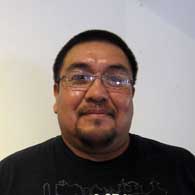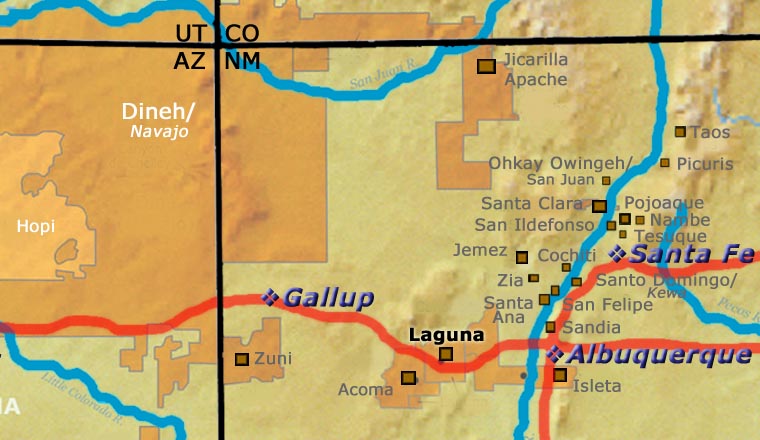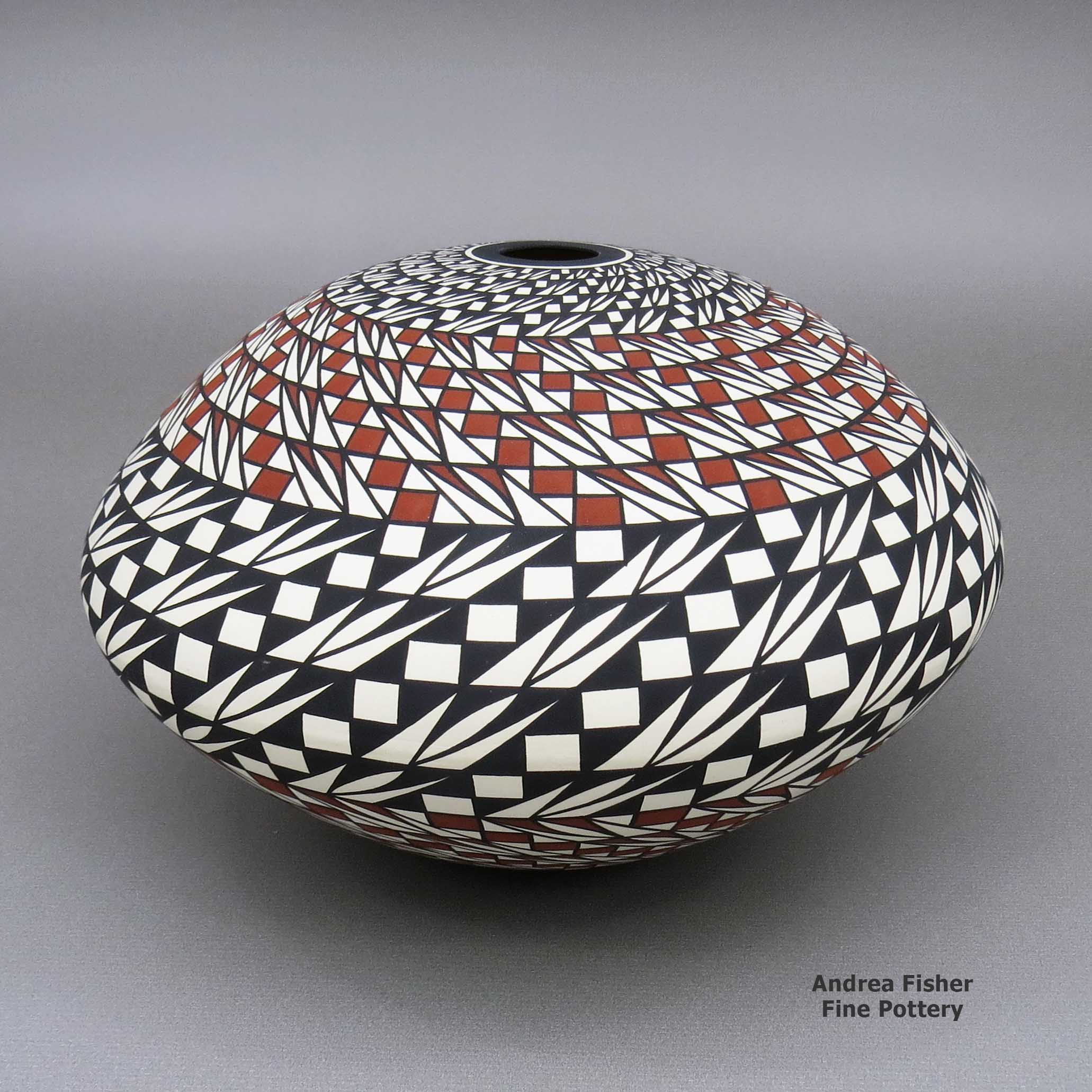| Dimensions | 6.75 × 6.75 × 4.75 in |
|---|---|
| Condition of Piece | Excellent |
| Signature | R. Kasero Sr. Laguna, NM |
| Date Born | 2023 |
Robert Kasero Sr, zzla3b081, Jar with a geometric design
$1,150.00
A polychrome jar decorated with a spiraling geometric design
In stock
- Product Info
- About the Artist
- Home Village
- Design Source
- About the Shape
- About the Design
- Family Tree
Brand
Kasero, Robert Sr
 Born in 1969 to Henry and Marie Kasero, Robert Kasero Sr., is a potter from Laguna Pueblo. His heritage is half Laguna, half Hopi. Early in his creative career he was carving Hopi katsinas, his favorite being the Kwaakatsina (the Eagle katsina). His mother had been a participant in the Laguna Arts and Crafts Project in 1973 and learned how to make pottery from Evelyn Cheromiah. Robert says he learned some of the traditional way of making pottery from his mother and some on his own but it was after becoming Paula Estevan's significant other that he really came into his own with Clay Mother. Paula has had a strong influence on his styles and designs but she says she leaves the details in his capable hands.
Born in 1969 to Henry and Marie Kasero, Robert Kasero Sr., is a potter from Laguna Pueblo. His heritage is half Laguna, half Hopi. Early in his creative career he was carving Hopi katsinas, his favorite being the Kwaakatsina (the Eagle katsina). His mother had been a participant in the Laguna Arts and Crafts Project in 1973 and learned how to make pottery from Evelyn Cheromiah. Robert says he learned some of the traditional way of making pottery from his mother and some on his own but it was after becoming Paula Estevan's significant other that he really came into his own with Clay Mother. Paula has had a strong influence on his styles and designs but she says she leaves the details in his capable hands.Like her work, his pieces are very thin walled and precisely painted, generally featuring a single design element that is repeated in an extremely fine, almost laser-like progressive pattern across the entire surface of the pot. Robert focuses on creating large seed pots that resemble sea urchins and he occasionally adds a full neck. His favorite designs are geometric, laid out such that a spiral is a straight line is a checked pattern (he calls it a "spiral mesa pattern"), and the whole is simply dazzling to the eye.
While their styles are similar, the two partners do not collaborate. Paula is so confident in his work that she "seldom even makes suggestions."
Robert tells us he gets his inspiration from the two most important women in his life: his mother and Paula. He also really enjoys when we tell him stories from his pleased collectors. He signs his work: "R. Kasero Sr., Laguna, NM."
A Short History of Laguna Pueblo
After the Pueblo Revolt of 1680, many pueblo people were fearful of Spanish reprisals. Spanish militias returned in 1681, 1682, 1685 and again in 1689. That first return brought them as far north as Isleta and that pueblo was attacked, looted and burned. The second return saw troops marching up to Santa Ana and San Felipe, attacking, looting and burning both. In those years, when the Puebloans became aware of approaching Spanish forces they mostly scattered into the mountains and the Spanish found empty villages, easy to loot and easy to burn.
When Don Diego de Vargas marched north in 1692, he was intent on reconquering Nuevo Mexico and re-establishing a long-term Spanish presence there. As the conquistadors who accompanied him were on a "do-or-die" mission, the reconquest took on a tenor quite different from the previous missions...
At first de Vargas followed a path of reconciliation with the pueblos but that was soon replaced with an iron fist that brought on a second revolt in 1696. The pueblos didn't fare so well the second time around and a large number of Pueblo warriors were executed while their wives and children were forced into slavery. When word of de Vargas' actions got back to the King of Spain, he ordered de Vargas banned from the New World. However, most of the damage was already done.
Many modern historians say Laguna Pueblo was established between 1697 and 1699 by refugees seeking to avoid fighting with the Spanish. Many of those refugees had left the first pueblos approached by the Spanish in 1692. First they scattered to more remote places like Acoma, Zuni and Hopi, or to more Spanish-friendly Isleta. However, the pressure of those refugees strained the resources of the other pueblos and quickly forced the refugees to consider starting a new existence in a newly-formed pueblo. The area of Laguna had been settled several hundred years previously by some ancestors of today's tribe. Other ancestors arrived during the periods of great drought that brought the Ancestral Puebloans (Anasazi) down from the Four Corners area to the areas where we now find the Rio Grande Pueblos. Some of the land under Laguna control has also been found to contain archaeological resources dating as far back as 3,000 BCE.
The prehistoric village of Pottery Mound is located just east of today's Laguna Pueblo boundary on Isleta land. Some archaeologists have said that Pottery Mound has more different shapes and forms of pottery and more designs on it than any other pottery center in the Rio Grande area. Pottery Mound was abandoned before the Spanish first arrived but archaeologists have followed the tracks left by Pottery Mound styles, shapes and designs to settlements in the Hopi mesas and the Four Corners area.
Life was relatively quiet at Laguna until the 1860s. That's when the US Government started looking for a southern route to run a railroad across America to the Pacific Coast. The first route chosen ran right across Laguna Pueblo, not far from the village itself. The Marmon brothers, Presbyterian missionaries who were also land surveyors, were sent to Laguna to proselytize and to work as surveyors. Both brothers married prominent women in the pueblo and come 1872, one of them was elected President of Laguna Pueblo. He immediately acted to destroy the remaining kivas on pueblo land. That forced a schism in the tribe and many of the fundamentalists (as in: traditional Lagunas) relocated downstream and built a pueblo with kivas at Mesita.
After more interference from the Christian government at Old Laguna, many of the Mesita folks packed up and headed for Sandia Pueblo. But they chose to travel via Isleta Pueblo and ended up stuck there: Isleta offered them refuge only if they guaranteed their clan ritual masks (and other accoutrements) would remain at Isleta forever. A few years later there were problems at Isleta and some of the Lagunas returned to Mesita while most of the others moved northeast on Isleta land and built a couple of smaller pueblos nearer to the mountains.
Over time, several villages were established in the area around Old Laguna and when the Lagunas were granted their own reservation, they were given about 500,000 acres of land. That made Laguna one of the largest of all pueblos in terms of land. However, today only about half the enrolled members of the tribe live at Laguna as many have been drawn to nearby Albuquerque in search of work.
In the 1950s uranium was discovered on Laguna land and after forcing negotiations with the tribal council, a huge open-pit mine was developed near Paguaté. That provided good-paying jobs for a few years but it also contaminated their water and land with radioactive pollutants. Cleanup happens at a snail's pace but is supposedly ongoing.
Today Laguna operates a number of commercial and industrial enterprises, including the Route 66 Casino and Resort along Interstate 40 on the west bank of the Rio Puerco.

For more info:
Laguna Pueblo at Wikipedia
Pueblo of Laguna official website
Discovering the Two-Spirit Artistry in the History of the Pueblo Pottery Revival, by Will Roscoe, © Feb. 2017
About Western Keresan Designs
Those of the Western Keres tradition have a plethora of traditional designs. A reason for that is they have occupied a region on the boundary between the Mogollon cultures to the south and the Ancestral Puebloan cultures to the north. And some of them have been living and working in the same place for a thousand years or more. They have also been making and breaking pottery the whole time. The area of Laguna has been more or less populated for a similar amount of time and, when populated, the Lagunas have moved around more than the Acomas.
Because Acoma and Laguna are located in that boundary area between Chaco Canyon influence to the north and Mogollon-Mimbres Valley influence to the south, designs and techniques have been coming and going across the landscape for many years. Over time, broken potsherds covered with multiple designs have fallen to the ground almost everywhere, just waiting to be picked up by someone, have their designs copied and revived, and their most basic constituents ground and mixed with fresh clay and to be reborn as pots again.
In the 1950s, that started happening a lot, potsherds being picked up and their designs revived, that is. Many of those designs have since been traced back to artisans in the Mimbres Valley working before 1150 CE. They had a unique perspective on the birds, animals, insects and people of their world, and used that perspective to draw and paint unique patterns. Many of those patterns are still being recreated on pottery across the Pueblo world, but especially at Acoma and Laguna. Central to the design palette are stories from the adventures of the Twin Warriors. While some Flower World iconography is also present in the Acoma design palette, there is extremely little from the kachina cults of the Hopi and Zuni.
One of the more recent "traditional" Acoma designs is the parrot holding a twig with berries in its claws. Often there is a rainbow above or below the parrot. Parrots are not natural in New Mexico, they had to have been imported. Before about 1450 CE, there was a trade in parrots and macaws through Paquimé to regions in the north. The remains of macaws have been pretty common but the remains of green parrots have only been recovered from three pueblos: Cicuyé, Paquimé and Grasshopper Pueblo in Arizona. The ancient-most Acoma parrot design has a Mimbres/Mogollon heritage while the parrot most painted today looks more like it came from an Amish trader's box. And it likely did.
With the arrival of Spanish colonists in New Mexico, pueblo potters changed their pottery to meet the demands of a new market. Their shapes and designs changed with that. Everything changed again with the arrival of Amish traders with their enameled cookware in the 1850s. The "new" Acoma parrot was pictured on the boxes those pots came in. The parrot came into being around 1880 and has been in use so long now it is considered "traditional."
Pottery was always in production at Acoma but from about 1600 to about 1950, it was heavily influenced by colonial shapes and designs. Eventually, the potters were reduced to producing items for the tourist trade to make ends meet, and that didn't go over so well either. Their own interest in making pottery fell off. Lucy Lewis, Jessie Garcia and Marie Z. Chino started decorating their pieces with their new interpretations of ancient Mimbres, Tularosa and Cibola designs in the 1920s and interest, both outside and inside the pueblo, grew again from there.
Laguna was impacted more heavily by the newcomers. Two Methodist missionaries married women in the pueblo and one of them shortly had himself elected President of the Pueblo. One of the first things he did was order the destruction of all the kivas on Laguna Pueblo land. That caused a schism and many Lagunas relocated to Isleta for a number of years (some of them are still there).
The Southern branch of the Transcontinental Railroad ran across Laguna Pueblo, and offered jobs to many of the men. That essentially ended the making of pottery by most tribal members. Then uranium was discovered under pueblo lands and more men went to work mining for that. Only a couple families passed the traditional knowledge down, until it eventually reached Evelyn Cheromiah. Nancy Winslow, an Anglo woman from Albuquerque, helped Evelyn obtain a grant to teach pottery making on the pueblo and a small revival started from there. Laguna potters, too, work their designs from designs they find on potsherds they find lying on the ground around the old pueblos. Their designs are very much like those of Acoma, usually just with more white space and bolder lines.
About Jars
The jar is a basic utilitarian shape, a container generally for cooking food, storing grain or for carrying and storing water. The jar's outer surface is a canvas where potters have been expressing their religious visions and stories for centuries.
In Sinagua pueblos (in northern Arizona), the people made very large jars and buried them up to their openings in the floors of the hidden-most rooms in their pueblo. They kept those jars filled with water but also kept smaller jars of meat and other perishables inside those jars in the water. It's a form of refrigeration still in use among indigenous people around the world.
Where bowls tend to be low, wide and with large openings, jars tend to be more globular: taller, less wide and with smaller openings.
For a potter looking at decorating her piece, bowls are often decorated inside and out while most jars are decorated only on the outside. Jars have a natural continuity to their design surface where bowls have a natural break at the rim, effectively yielding two design surfaces on which separate or complimentary stories can be told.
Before the mid-1800s, storage jars tended to be quite large. Cooking jars and water jars varied in size depending on how many people they were designed to serve. Then came American traders with enameled metal cookware, ceramic dishes and metal eating utensils...Some pueblos embraced those traders immediately while others took several generations to let them and their innovations in. Either way, opening those doors led to the virtual collapse of utilitarian pottery-making in most pueblos by the early 1900s.
In the 1920s there was a marked shift away from the machinations of individual traders and more toward marketing Native American pottery as an artform. Maria Martinez was becoming known through her exhibitions at various major industrial fairs around the country and Nampeyo of Hano was demonstrating her art for the Fred Harvey Company at the Grand Canyon. The first few years of the Santa Fe Indian Market helped to solidify that movement and propel it forward. It took another couple generations of artists to open other venues for their art across the country and turn Native American art into the phenomenon it has become.
Today's jars are artwork, not at all for utilitarian purposes, and their shapes, sizes and decorations have evolved to reflect that shift.
About Geometric Designs
"Geometric design" is a catch-all term. Yes, we use it to denote some kind of geometric design but that can include everything from symbols, icons and designs from ancient rock art to lace and calico patterns imported by early European pioneers to geometric patterns from digital computer art. In some pueblos, the symbols and patterns denoting mountains, forest, wildlife, birds and other elements sometimes look more like computer art that has little-to-no resemblance to what we have been told they symbolize. Some are built-up layers of patterns, too, each with its own meaning.
"Checkerboard" is a geometric design but a simple black-and-white checkerboard can be interpreted as clouds or stars in the sky, a stormy night, falling rain or snow, corn in the field, kernels of corn on the cob and a host of other things. It all depends on the context it is used in, and it can have several meanings in that context at the same time. Depending on how the colored squares are filled in, various basket weave patterns can easily be made, too.
"Cuadrillos" is a term from Mata Ortiz. It denotes a checkerboard-like design using tiny squares filled in with paints to construct larger patterns.
"Kiva step" is a stepped geometric design pattern denoting a path into the spiritual dimension of the kiva. "Spiral mesa" is a similar pattern, although easily interpreted with other meanings, too. The Dineh have a similar "cloud terrace" pattern.
That said, "geometric designs" proliferated on Puebloan pottery after the Spanish, Mexican and American settlers arrived with their European-made (or influenced) fabrics and ceramics. The newcomers' dinner dishes and printed fabrics contributed much material to the pueblo potters design palette, so much and for so long that many of those imported designs and patterns are considered "traditional" now.
Evelyn Cheromiah Family & Teaching Tree - Laguna Pueblo
Disclaimer: This "family tree" is a best effort on our part to determine who the potters are in this group and arrange them in a generational order. The general information available is questionable so we have tried to show each of these diagrams to living members of each family to get their input and approval, too. This diagram is subject to change should we get better info.
Evelyn worked with Nancy Winslow, an Anglo woman from Albuquerque, to set up what became the 1973 Laguna Arts and Crafts Project. At that time, only Evelyn and a couple potters in the village of Mesita were still making Laguna pottery. Those women were teaching their daughters, too, but it was clearly a dying art. Evelyn and Nancy secured enough funding for Evelyn to teach two 4-month sessions of pottery making classes. Both groups were filled to overflowing.
- Evelyn Cheromiah (1928-2013)
- Lee Ann Cheromiah (1954-)
- Brooke Cheromiah
- Mary Cheromiah Victorino (c. 1950's-)
- Wendy Cheromiah Kowemy
- Wendell Kowemy (1972-)
- Josephita Cheromiah
- Elton Cheromiah
- Calvin Analla Jr. (1958-)
- Elsie Chereposy
- Mabel Poncho (c. 1920s-)
- Bertha Riley (niece) & Stuart Riley Sr. (Dineh)
- Marie Kasero




